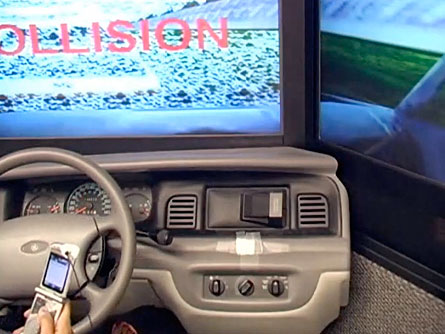Texting and driving don’t mix, just as suspected
Sending or receiving messages proves even worse than cell phone calls for young adults on simulators
Text messaging while driving leads to slowed reaction time, unplanned lane changes and more collisions, according to a new study published online December 21 in Human Factors. The finding bolsters other research showing that texting and even using MP3 players don’t mix well with driving.

This finding might seem like a no-brainer, and in some states texting while driving is illegal. But the effects of texting while driving have not been extensively studied, says study coauthor Frank Drews, a cognitive psychologist at the University of Utah in Salt Lake City.
The practice is certainly widespread among young drivers. A recent Pew Research Center survey found that one-fourth of adolescents age 16 or 17 reporting having texted while driving and nearly half of teenagers of all ages report having been in a car while the driver was texting.
To identify whether texting while driving is inherently dangerous, Drews and his colleagues enrolled 20 pairs of friends who ranged in age from 19 to 23 and averaged nearly five years of driving experience. These friends commonly texted each other and read text messages while driving. Nearly all had sent text messages while behind the wheel.
Each volunteer took a turn “driving” in a simulator that replicated 32 miles of urban and rural freeway with on- and off-ramps, overpasses and cars passing on the left. The drivers were instructed to obey traffic rules and follow a car in front of them in the right lane.
In portions of the test, the drivers would not receive or send phone calls or messages. Other times, a driver’s friend would send text messages or would call, with the goal to make plans for the evening. The drivers were tasked to respond while driving, using their own phones. Meanwhile, the car ahead would periodically brake to slow down and then speed up again.
The drivers’ behavior changed while texting. They were twice as likely to veer out of their lane and were substantially slower to brake when the car ahead slowed, compared with driving without distractions. Although texting drivers left a greater distance between themselves and the car ahead, their response time to another car’s brake lights was so impaired that this buffer was often negated. Even with the buffer, the texting drivers would pull up close to that car more often than when they weren’t texting.
“We call this the yo-yo effect. They would fall back and come close,” Drews says.
There were seven collisions during the simulations, six of which were caused by drivers while they were texting.
The scientists also measured drivers’ reaction time while talking on cell phones in busy traffic. Those texting fared far worse than talkers.
This sort of disruption showed up in a 2009 study of teenage drivers that was conducted by a team at Eastern Virginia Medical School in Norfolk. Those researchers found that any electronic devices requiring finger work — such as dialing a cell phone, sending a text message or fiddling with an MP3 player — impair driving. While operating these devices, “boys tend to speed up and girls slow down,” says study coauthor Donald Lewis, a pediatric neurologist. The distraction led to more traffic violations in simulations of driving through urban areas, he says.
Also in 2009, a team of researchers at Monash University in Melbourne, Australia, reported that 20 novice drivers on simulators often fell into the “yo-yo” trap while text messaging and veered side to side more than they did during undistracted driving. The drivers had their eyes off the road four times longer than when not texting, the scientists found.
These scientists say cell phone calls, texting and MP3 players compete for attention and can occupy the driver’s vision, hearing, cognitive focus and ultimately motor skills.
Linda Boyle is a civil engineer at the University of Washington in Seattle who studies driving distractions. While at the University of Iowa in Iowa City, she and her colleagues surveyed teens and found that eating, putting on makeup, talking to passengers and texting were high on the list of distractions.
In a 2008 study, the Iowa team reviewed traffic crash data involving drivers age 16 to 19 and found that injuries — especially for passengers — were more severe when the driver’s cell phone use was listed on the police report.
“Here’s a bunch of young people who are not seasoned veterans behind the wheel and they are distracted from the primary task of driving,” Lewis says. “It’s absolutely a double whammy.”
Lewis, a physician, has taken his own research to heart. “When my beeper goes off, I pull over,” he says.
Driving While Texting from Science News on Vimeo.
Hang up and drive – This video shows student volunteers at the University of Utah sending and receiving text messages while simultaneously driving on a traffic simulator.
Video Credit: University of Utah







